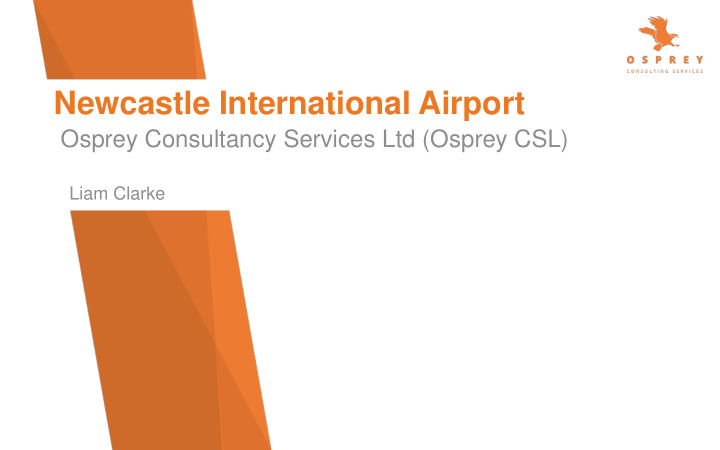



Newcastle International Airport Osprey Consultancy Services Ltd (Osprey CSL) Liam Clarke
• Who Are Osprey? • Standard Instrument Departures(SIDs) Overview Overview • Features of a SID • The Airspace Change Process
• Privately owned technical consultancy founded in 2006 • Specialising in operational and About engineering support to both civil and military aviation projects Osprey CSL • Independent – work with Government Agencies, Regulatory Authorities, Equipment Providers and Airport Operators 3
Instrument Flight Procedure (IFP) Design 4
IFP Design • Operate under gCAP, a wholly owned Company of Osprey CSL • Approved Procedure Designers with the UK Civil Aviation Authority • IFP team based in Northallerton • IFP sole contractors to No1 Aeronautical Information Documents Unit (AIDU) Royal Air Force
• Commissioned in 2018 to consider options for departures to the West • Report delivered in 2018 • Initial work was completed under CAP725 Framework • Any future CAP1616 ACP submission may be prejudiced by the release of specific tracks
Performance Based Navigation (PBN) Standard Instrument Departures (SIDs) 7
PBN Standard Instrument Departures • SIDs are CAA Approved instrument departures published in the State AIP • PBN SIDs - Provide a navigation solution to enable Departing aircraft to adhere to the 3km Noise Abatement Procedure at Newcastle - Some dispersion will always be apparent during PBN initial turns due to Aircraft performance, wind effect and avionics performance. 8
Features of SIDs • Provide a safe ‘known obstacle’ environment for departing aircraft by defining routes • Instrument Flight Procedures allow flight planners to accurately assess fuel requirements leading to less emissions and cost savings • No turns permitted below 500ft Above Aerodrome Level (AAL) • 3.3% Standard procedure design gradient • Fleet specific climb rates <10% 9
Airspace Change Process 10
Civil Aviation Publication (CAP) 725 /1616 Airspace Change Process 11
CAP 1616 – Seven Stage Process • Seven Stages – Approx. 5 Year timeframe - Develop a comprehensive list of design options - Options Appraisal to develop a shortlist of options - Detailed design of selected options - Ground Validation of options - Re-design following consultation and Civil Aviation Authority (CAA) comment - Stakeholder engagement support - Safety Assessments • Iterative as described in accordance with CAP 1616 12
CAP 1616 Airspace Change Process • Stage 1 - Step 1A Assess Requirement Statement of Need • Is an ACP relevant option • • Appropriate scale of Airspace Change - Step 1B Design Principles • Engagement with stakeholder • Qualitative structure against which design options can be evaluated Safety, Environmental, Operational and strategic • policy objectives
Contact us: www.ospreycsl.co.uk 14
Recommend
More recommend